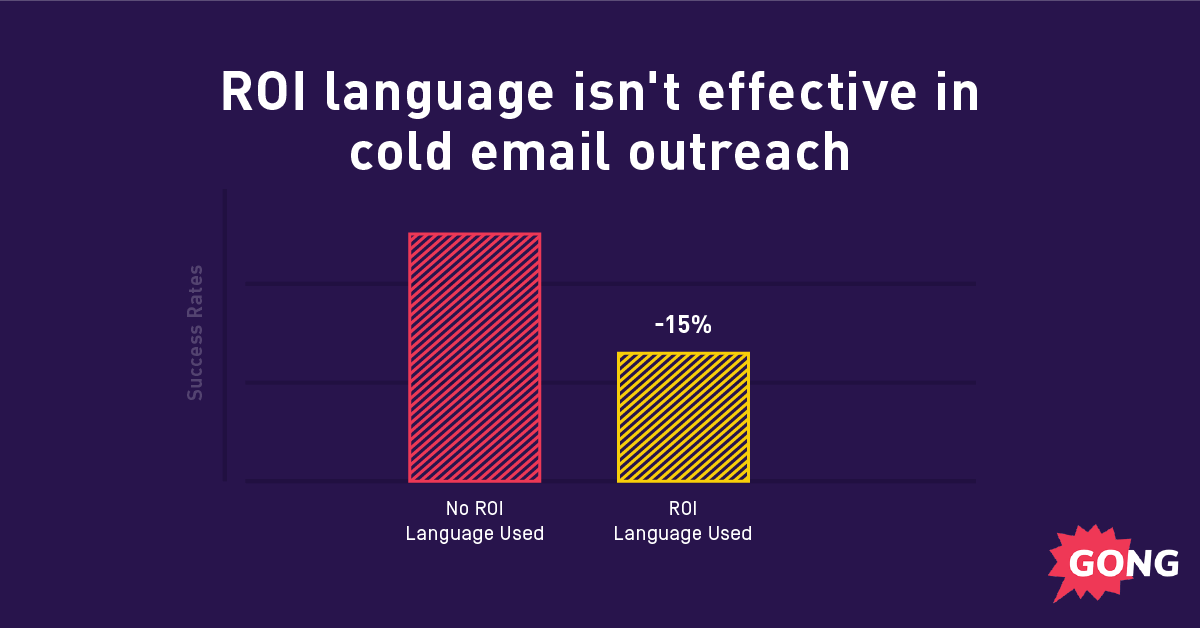Avoid these 5 mistakes when talking ROI with execs
Gong Labs’ previous research shows that it’s not a great idea to send executives cold emails with lofty ROI promises (see chart below for a sneak peek). How on earth can that be a bad idea, when all customers care about is ROI?

Picture this: You’re a software sales rep and you gave a stellar demo to your customer’s CFO. They said the demo was interesting, and asked for clarification on your solution’s ROI.
You dug through marketing materials and found a slide showing a 40x ROI. In other words, for every dollar your customer spends, they get 40 dollars in return. Happy you found the slide, you sent it to the CFO, who called it bogus and disengaged.
But wait… you gave the CFO exactly what they were asking for! What did you do wrong? What could you have done better?
The best person to answer this question is probably, well… a CFO. And I couldn’t think of a better CFO to speak with about this topic than Gong’s very own Tim Riiters. When Tim and I chatted, we zeroed in on five common mistakes sellers make when talking ROI with their customers, especially execs:
Mistake #1: Focusing on ROI, not >benefits
Businesses are complex. ROI calculations are complex. And you’re a sales professional, not a financial wiz. Your financial ROI calculations may not be taken seriously. So instead of focusing on ROI, talk about benefits you can stand behind. Your financially savvy prospects will know how to translate them into money.
Mistake #2: Not using relevant benchmarks
If you tell a prospect they’ll improve their win rate by 5%, be sure you can explain where that 5% figure comes from. You’ll really get a customer’s attention if you show them figures from relatable use cases. For example, if a customer in manufacturing wants to improve the lead conversion rates for a team of 50 reps, show them lead conversion stats for mid-market companies in the manufacturing industry. If you don’t have an industry benchmark repository now, consider creating one as soon as possible.
Mistake #3: Not using the right metrics
You need to tailor your message to your customer’s strategic priorities. Before you show your customer numbers or share your product’s benefits, do some discovery so you understand their strategic priorities. If your customer is interested in improving their lead conversion, don’t show them improvements in opportunity win rate. If you don’t have solid benchmarks for your use cases, but you still believe your solution can help, be upfront and tell that story. Read about how stories can be more powerful than numbers here.
Mistake #4: Overcomplicating the value story
A simple value story is a reliable value story. Don’t stretch your product’s benefits too far. Here’s what an overcomplicated value story with unreasonable value attribution looks like:
Our solution can save your reps 30% in admin time, so they’ll have more time to sell (really?), will sell more (really??), and will get your revenue up by 30% (really???).
Here’s the story they should have told:
Our solution can save your reps 30% in admin time.
That’s it. That’s all. Have a conversation with your prospect, and together you can build a story about what admin time savings means for them. Maybe it’s an increase in sales or maybe it’s a better employee experience that reduces turnover rates.
Mistake #5: Treating soft savings as hard savings
If your solution can save reps 30% of their admin time (soft savings), never equate that with a 30% reduction in employment costs (hard savings). Time savings are only highly correlated with cost savings in very particular cases, like when workers’ tasks are unified and well defined (e.g., a factory assembly line). In most cases, they aren’t correlated. If you make this mistake, it will be hard for your customer to see the real return on their investment.
Before your next CFO meeting…
Keep these five common mistakes in mind. The next time a customer asks you about ROI, switch to value drivers that are relevant to their organization, benchmarks from similar customers, and a compelling value narrative.
Once you do that, your last hurdle these days is budget. It’s a daunting one, that’s for certain, but there are simple ways to get approval. You can start by downloading our CFO letter template here. It’s the key to helping your champion unfreeze budget so you can both move past the CFO. With your potential ROI missteps under control and your champion offering up the right information, you’ll provide a deeper understanding of your product and remain a trusted and reliable source. Mission accomplished.
